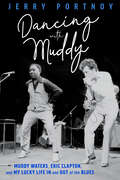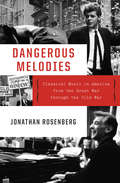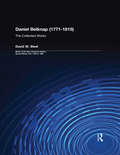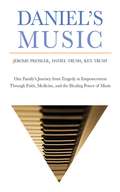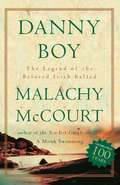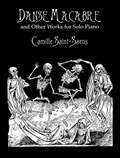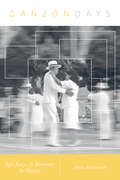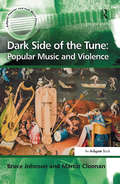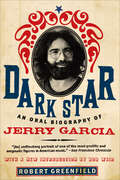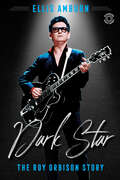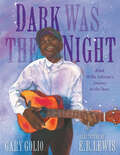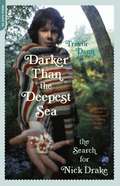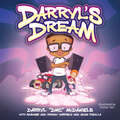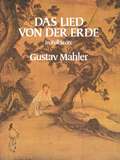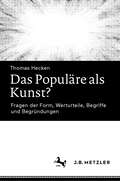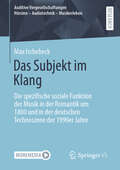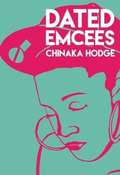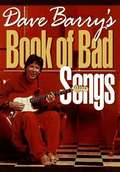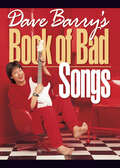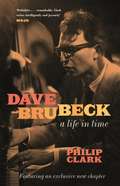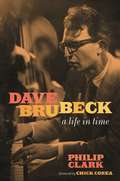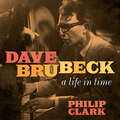- Table View
- List View
Dancing with Muddy: Muddy Waters, Eric Clapton, and My Lucky Life In and Out of the Blues
by Jerry PortnoyJerry Portnoy grew up in Chicago hearing the blues being played outside his father's rug store on famed Maxwell Street during the late 1940s and early '50s. After dropping out of college, he became immersed in the colorful world of pool hustlers like Cornbread Red, and Minnesota Fats as he managed the largest pool hall in Chicago. During a stint as a paratrooper early in the Vietnam war, he applied for discharge as a conscientious objector, and lived in San Francisco during 1967's "summer of love." While bumming around Europe the following year, Portnoy heard the blues again on a record by Sonny Boy Williamson and instantly became obsessed with mastering blues harmonica. He returned to Chicago and in 1974 he was playing in small Black clubs at night when Muddy Waters plucked him from his day job at Cook County Jail to fill the historic harmonica chair in his fabled band. Eric Clapton followed suit in 1991. In a career that took him from ghetto taverns to the White House and the Royal Albert Hall, he went from the raggedy vans and cheap roadside motels of the blues world to the private jets and five-star hotels of the rock world. Between those two very different gigs was a struggle to survive the vagaries of the music business and the pressures of life on the road. In a remarkable life, he also assisted in surgery, lodged in a Moroccan house of ill repute, and dined at Giorgio Armani's. Dancing with Muddy details the surprising, lively, and sometimes bumpy ride of a blues harmonica legend.
Dangerous Melodies: Classical Music In America From The Great War Through The Cold War
by Jonathan RosenbergA Juilliard-trained musician and professor of history explores the fascinating entanglement of classical music with American foreign relations. Dangerous Melodies vividly evokes a time when classical music stood at the center of twentieth-century American life, occupying a prominent place in the nation’s culture and politics. The work of renowned conductors, instrumentalists, and singers—and the activities of orchestras and opera companies—were intertwined with momentous international events, especially the two world wars and the long Cold War. Jonathan Rosenberg exposes the politics behind classical music, showing how German musicians were dismissed or imprisoned during World War I, while numerous German compositions were swept from American auditoriums. He writes of the accompanying impassioned protests, some of which verged on riots, by soldiers and ordinary citizens. Yet, during World War II, those same compositions were no longer part of the political discussion, while Russian music, especially Shostakovich’s, was used as a tool to strengthen the US-Soviet alliance. During the Cold War, accusations of communism were leveled against members of the American music community, while the State Department sent symphony orchestras to play around the world, even performing behind the Iron Curtain. Rich with a stunning array of composers and musicians, including Karl Muck, Arturo Toscanini, Wilhelm Furtwängler, Kirsten Flagstad, Aaron Copland, Van Cliburn, and Leonard Bernstein, Dangerous Melodies delves into the volatile intersection of classical music and world politics to reveal a tumultuous history of twentieth-century America.
Dangerous Rhythms: Jazz and the Underworld
by T. J. EnglishFrom T. J. English, the New York Times bestselling author of Havana Nocturne, comes the epic, scintillating narrative of the interconnected worlds of jazz and organized crime in 20th century America."[A] brilliant and courageous book." —Dr. Cornel WestDangerous Rhythms tells the symbiotic story of jazz and the underworld: a relationship fostered in some of 20th century America’s most notorious vice districts. For the first half of the century mobsters and musicians enjoyed a mutually beneficial partnership. By offering artists like Louis Armstrong, Earl “Fatha” Hines, Fats Waller, Duke Ellington, Billie Holiday, Lena Horne, and Ella Fitzgerald a stage, the mob, including major players Al Capone, Meyer Lansky, and Charlie “Lucky” Luciano, provided opportunities that would not otherwise have existed.Even so, at the heart of this relationship was a festering racial inequity. The musicians were mostly African American, and the clubs and means of production were owned by white men. It was a glorified plantation system that, over time, would find itself out of tune with an emerging Civil Rights movement. Some artists, including Louis Armstrong, believed they were safer and more likely to be paid fairly if they worked in “protected” joints. Others believed that playing in venues outside mob rule would make it easier to have control over their careers.Through English’s voluminous research and keen narrative skills, Dangerous Rhythms reveals this deeply fascinating slice of American history in all its sordid glory.
Daniel Belknap: The Collected Works (Music of the New American Nation: Sacred Music from 1780 to 1820)
by David Warren SteelDaniel Belknap was a farmer, mechanic, and singing-master in Framingham, Massachusetts, who compiled four sacred and one secular tunebooks. These featured his own sacred compositions as well as those by other New England composers. While Belknap was not as flamboyant, prolific, nor as innovative as his contemporaries, he nevertheless provided fitting and eloquent religious and social music for his own and neighboring communities.
Daniel's Music: One Family's Journey from Tragedy to Empowerment Through Faith, Medicine, and the Healing Power of Music
by Jerome Preisler The Trush FamilyIn 1997, Daniel Trush, a bright, active, outgoing twelve-year-old, collapsed on the basketball court and fell into a deep coma. Rushed to the hospital, he was found to have five previously undetected aneurysms in his brain. One had burst, causing a massive cerebral hemorrhage.While Daniel remained comatose, the uncontrolled pressure inside his skull caused him to suffer multiple strokes. Tests showed that his brain functions had flat-lined, and doctors would soon tell his parents his chances of survival were slim to none--or that he'd likely remain in a vegetative state if he awakened.But the doctors were wrong.Daniel's traumatic injury did not bring his life to a premature end. Thirty days after lapsing into a coma, he would return to consciousness, barely able to blink or smile. Two years later, he took his first extraordinary steps out of a wheelchair. A decade after being sped to the emergency room, Daniel Trush completed the New York Marathon.But his incredible journey into the future had just begun. With music having played a crucial role in his recovery, Danny and his family launched Daniel's Music Foundation, a groundbreaking nonprofit organization for people with disabilities. In time DMF would be honored on a Broadway stage by the New York Yankees, gaining notoriety and admiration across America.Daniel's Music is the gripping story of Daniel's recovery against odds experts said were insurmountable; of medical science, faith, and perseverance combining for a miracle; and of an average family turning their personal trials into a force that brings joy, inspiration, and a powerful sense of belonging to all those whose lives they touch.
Danny Boy: The Legend Of The Beloved Irish Ballad
by Malachy MccourtEveryone can hum this haunting Irish ballad that inevitably brings a tear to the eye. The most requested Irish song, it has been recorded by a variety of performers ranging from Elvis Presley, Bing Crosby, and Kate Smith to the Pogues. The complete story of this moving tune has been shrouded in mystery until now. Where did Danny Boy originate, who actually wrote the lyrics, and is it even Irish? Acclaimed novelist, actor, memoirist, screenwriter, playwright, and raconteur, Malachy McCourt, turns his Irish eye to the song's complex history and myths in an eloquent ode to this classic. He traces the evolution of the music, which is one of more than 100 songs composed to the very same tune, including the familiar Londonderry Air, and explores the enduring mystique of Danny Boy in an unforgettable tribute that brilliantly weaves history with folklore.
Danse Macabre and Other Works for Solo Piano (Dover Classical Piano Music)
by Camille Saint-SaënsSplendid compilation features a variety of the composer's best piano works, all reproduced from authoritative sources. Taking its title from the popular orchestral work "Danse Macabre" (presented here in the brilliant arrangement by Liszt), this collection also includes "Allegro appassionato," "Album" (consisting of 6 pieces), "Rhapsodie d'Auvergne," "Theme and Variations," plus 6 etudes, 3 waltzes, and 6 etudes for left hand alone. Introduction.
Danzón Days: Age, Race, and Romance in Mexico (Music in American Life)
by Hettie MalcomsonOlder people negotiating dance routines, intimacy, and racialized differences provide a focal point for an ethnography of danzón in Veracruz, the Mexican city closely associated with the music-dance genre. Hettie Malcomson draws upon on-site research with semi-professional musicians and amateur dancers to reveal how danzón connects, and does not connect, to blackness, joyousness, nostalgia, ageing, and romance. Challenging pervasive utopian views of danzón, Malcomson uses the idea of ambivalence to explore the frictions and opportunities created by seemingly contrary sentiments, ideas, sensations, and impulses. Interspersed with experimental ethnographic vignettes, her account takes readers into black and mestizo elements of local identity in Veracruz, nostalgic and newer styles of music and dance, and the friendships, romances, and rivalries at the heart of regular danzón performance and its complex social world. Fine-grained and evocative, Danzón Days journeys to one of the genre’s essential cities to provide new perspectives on aging and romance and new explorations of nostalgia and ambivalence.
Dark Side of the Tune: Popular Music And Violence (Ashgate Popular And Folk Music Ser.)
by Martin CloonanWritten against the academically dominant but simplistic romanticization of popular music as a positive force, this book focuses on the 'dark side' of the subject. It is a pioneering examination of the ways in which popular music has been deployed in association with violence, ranging from what appears to be an incidental relationship, to one in which music is explicitly applied as an instrument of violence. A preliminary overview of the physiological and cognitive foundations of sounding/hearing which are distinctive within the sensorium, discloses in particular their potential for organic and psychic violence. The study then elaborates working definitions of key terms (including the vexed idea of the 'popular') for the purposes of this investigation, and provides a historical survey of examples of the nexus between music and violence, from (pre)Biblical times to the late nineteenth century. The second half of the book concentrates on the modern era, marked in this case by the emergence of technologies by which music can be electronically augmented, generated, and disseminated, beginning with the advent of sound recording from the 1870s, and proceeding to audio-internet and other contemporary audio-technologies. Johnson and Cloonan argue that these technologies have transformed the potential of music to mediate cultural confrontations from the local to the global, particularly through violence. The authors present a taxonomy of case histories in the connection between popular music and violence, through increasingly intense forms of that relationship, culminating in the topical examples of music and torture, including those in Bosnia, Darfur, and by US forces in Iraq and Guant mo Bay. This, however, is not simply a succession of data, but an argumentative synthesis. Thus, the final section debates the implications of this nexus both for popular music studies itself, and also in cultural policy and regulation, the ethics of citizenship, and arguments about human
Dark Star: An Oral Biography of Jerry Garcia
by Robert GreenfieldFor more than thirty years, Jerry Garcia was the musical and spiritual center of the Grateful Dead, one of the most popular rock bands of all time. In Dark Star, the first biography of Garcia published after his death, Garcia is remembered by those who knew him best. Together the voices in this oral biography explore his remarkable life: his childhood in San Francisco; the formation of his musical identity; the Dead's road to rock stardom; and his final, crushing addiction to heroin. Interviews with Jerry's former wives, lovers, family members, close friends, musical partners, and cultural cohorts create a behind-the-scenes look at the making of a rock-and-roll icon—and at the price of fame.
Dark Star: The Roy Orbison Story
by Ellis AmburnThis biography reveals the rock music legend’s dramatic life story, from his Texas youth and rise to stardom to his personal tragedies and untimely death.A true legend of American popular music, Roy Orbison perfected the soulful rock ballad, recording such perennial hits as “Only the Lonely” and “Crying.” In Dark Star, biographer Ellis Amburn reveals the stories behind his achingly beautiful sound. Amburn explores Orbison’s rockabilly roots, his first deal with Sun Records, and his numerous Billboard Top 40 hits. Amburn then delves into the personal tragedies, including the sudden deaths of his wife and two of his children, that led to his obscurity. His return to stardom is also covered in detail, including his work with the supergroup The Traveling Wilburys and his posthumous hit single “You got It.”
Dark Was the Night: Blind Willie Johnson's Journey to the Stars
by Gary GolioThe poignant story of Blind Willie Johnson--the legendary Texas musician whose song "Dark Was the Night" was included on the Voyager I space probe's Golden RecordWillie Johnson was born in 1897, and from the beginning he loved to sing--and play his cigar box guitar. But his childhood was interrupted when he lost his mother and his sight. How does a blind boy make his way in the world? Fortunately for Willie, the music saved him and brought him back into the light. His powerful voice, combined with the wailing of his slide guitar, moved people. Willie made a name for himself performing on street corners all over Texas. And one day he hit it big when he got a record deal and his songs were played on the radio. Then in 1977, his song--"Dark Was the Night"--was chosen to light up the darkness when it was launched into space on the Voyager I space probe's famous Golden Record. His immortal song was selected for the way it expresses the loneliness humans all feel, while reminding us we're not alone.
Darker Than the Deepest Sea: The Search for Nick Drake
by Trevor DannWhen Nick Drake (1948-1974) died of a drug overdose at twenty-six, he left behind three modest-selling albums, including the stark Pink Moon and the lush Bryter Layter. Three decades later, he is recognized as one of the true geniuses of English acoustic music. Yet Nick Drake--whose music was as gentle and melancholy as the man himself-- has always maintained a spectral presence in popular music. This groundbreaking biography reconstructs a vanished life while perfectly capturing the bohemian scenes surrounding the music business in London in the late '60s and early '70s. Using many newly discovered documents and all-new interviews, Trevor Dann reveals more detail on Nick Drake than ever, from his upbringing in a quintessentially English village, through his hash-fueled school days at Cambridge University, to the missed opportunities and mismanagement that defined his career. Friends and colleagues describe the difficulties that he faced as each new album was released, only to fail, and the insidious despair that consumed him. Complete with discography and rare photos, Darker Than the Deepest Sea is essential reading for anyone who has been moved by Nick Drake's unforgettable blend of beauty and sadness.
Darryl's Dream
by Darryl "DMC" McDaniels Shawnee Warfield Johnny Warfield Adam PadillaFrom hip-hop pioneer Darryl &“DMC&” McDaniels comes Darryl&’s Dream, a new picture book about creativity, confidence, and finding your voice.Meet Darryl, a quiet third grader with big hopes and dreams. He loves writing and wants to share his talents, but he&’s shy—and the kids who make fun of his glasses only make things worse. Will the school talent show be his chance to shine? Darryl&’s Dream, by iconic performer Darryl "DMC" McDaniels, is a story about finding confidence, facing bullies, and celebrating yourself. This full-color picture book is certain to entertain children and parents with its charming art and important message.
Das Lied von der Erde in Full Score (Dover Music Scores)
by Gustav MahlerIn Das Lied von der Erde, Gustav Mahler fused the two forms that most obsessed him -- song and symphony -- into a masterpiece that epitomized his musical genius and the very spirit of late Romanticism. It is a work of stunning power, one that musical artists and audiences worldwide have made a repertoire favorite, and it is reprinted here from the original full score published in Vienna by Universal-Edition in 1912.Based on a cycle of six poems translated from the Chinese by Hans Bethge, Das Lied von der Erde, scored for tenor, alto (or baritone), and orchestra, expresses a dualism of feeling -- ecstatic pleasure shadowed by dark foreboding -- that characterizes not only Mahler himself but the peculiarly autumnal mood of late Romanticism as well. Throughout, Mahler calls on the orchestra to suggest the exotic atmosphere summoned by the text, and to sustain and supplement the solos with all its resources, both in the accompaniment and the extensive connecting interludes.This sturdily bound, finely produced full score, containing an English translation of the song text is printed on fine-quality paper. It offers both amateur and professional singers and musicians -- along with music lovers who enjoy following a love or recorded performance, score in hand -- a lifetime of pleasurable study and intimate enjoyment of one of the most celebrated classics of 20th-century music.
Das Populäre als Kunst?: Fragen der Form, Werturteile, Begriffe und Begründungen
by Thomas HeckenPopulären Werken wird seit Jahrhunderten der Status des Kunstwerks aberkannt, unter Verweis auf deren vermeintliche Oberflächlichkeit, Eindimensionalität, Effekthascherei und Standardisierung werden sie streng von ‚echter‘ Kunst geschieden. Schiller, Nietzsche, Adorno, Greenberg, unzählige Kritiker und Feuilletonisten in Westeuropa und den USA – sie alle eint ein starker Vorbehalt gegenüber dem, was von den Vielen anerkannt, geschätzt und gekauft wird. Seit Beginn des 18. Jahrhunderts und besonders seit den 1950er Jahren gibt es aber auch eine Reihe von Argumenten gegen die Auffassung, dass nichts Kunst sei, was auf große Zustimmung trifft. Die Fülle an unterschiedlichen Positionen, Aussagen und Argumentationsmöglichkeiten aufzuzeigen, zu bündeln, zu systematisieren und zu überprüfen, die dem Populären zu künstlerischer Anerkennung verhelfen wollen, ist Zweck dieses Buches. Das Resultat ist eine umfassende Darstellung von Gründen, auch populäre Werke aus Literatur, Musik, Film, Fotografie, bildender Kunst und Design als genuine Kunstwerke betrachten zu können.
Das Subjekt im Klang: Die spezifische soziale Funktion der Musik in der Romantik um 1800 und in der deutschen Technoszene der 1990er Jahre (Auditive Vergesellschaftungen Hörsinn - Audiotechnik - Musikerleben)
by Max IschebeckMusik ist mit unzähligen sozialen Prozessen und Situationen in unterschiedlichen Bereichen der Gesellschaft verknüpft. Dabei wird sie völlig anders eingesetzt, rezipiert und erfahren als andere Medien, etwa als die Schrift, die gesprochene Sprache oder Bilder. Vor diesem Hintergrund ist es überraschend, dass die Soziologie sich kaum für die Bedeutung der Musik in der Gesellschaft sowie für das Besondere dieses Mediums in seinem sozialen Kontext interessiert. Die Arbeit fragt deshalb in zwei Teilstudien nach der spezifischen sozialen Funktion der Musik. In der frühen Romantik und in der deutschen Technoszene der 1990er Jahre wird die Musik, so arbeitet der Autor heraus, zur Konstitution und Organisation von Subjektkulturen eingesetzt. Die Klänge sind ein Mittel zur Hervorbringung von Praxisformen und Diskurselementen, mit denen sich neue Formen des Ichs beschreiben und erproben lassen. Sowohl die Romantiker*innen als auch die Raver*innen hören das emphatisch idealisierte, kollektive Ich zudem in der Musik heraus. Sie wird so zu einem integrativen Symbol, das alle im Entstehen begriffenen Wissensgehalte und Handlungsweisen der Subjektform umfasst.
Das verdächtig Populäre in der Musik: Warum wir mögen, wofür wir uns schämen
by Marina SchwarzOft und gerne gehört, selten untersucht – in diesem Buch geht es um Musikvorlieben, die einem selbst peinlich sind: Kitsch, Camp, Trash. Jenseits des guten Geschmacks tun sich Abgründe auf, in die dieser Sammelband gerne hineinblickt. Ziel ist es, bisher in der Forschung unterrepräsentierte, aber gesellschaftlich breit konsumierte Formen von Musik zu beleuchten und mithilfe verschiedener methodischer Zugänge auch die Frage nach den Gründen für eine negative Bewertung dieser Musikarten herauszufinden. Die Beiträge stammen hauptsächlich aus den Bereichen Musiksoziologie, Popularmusikforschung und der historischen Musikwissenschaft.
Dated Emcees
by Chinaka HodgeChinaka Hodge came of age along with hip-hop-and its influence on her suitors became inextricable from their personal interactions. Form blends with content in Dated Emcees as she examines her love life through the lens of hip-hop's best known orators, characters, archetypes and songs, creating a new and inventive narrative about the music that shaped the craggy heart of a young woman poet, just as it also changed the global landscape of pop.Praise for Dated Emcees:"In the old tellings hip-hop was a woman, a certain kind-one needing, even begging to be saved. In Dated Emcees, Chinaka Hodge gives her a voice and she tells of her loves and desires, her traumas and pains in words as hard, as lit, as loving, cunning, cutting, ecstatic, as tender and devastating as her big world requires. This is poetry that, in its infinite power and intimate grace, will still turn in your mind long after the music is over."-Jeff Chang, author of Who We Be: A Cultural History of Race in Post-Civil Rights America"Hodge writes with an unpredictable, rare honesty. This collection quietly and simply illustrates love in a complicated world."-Donald Glover AKA Childish Gambino"This is an absolute powerhouse of a book, and a new pinnacle for Chinaka Hodge. There's enough beauty and heartbreak and melancholy and humor and sorrow in here for three collections, or two lifetimes. Hodge's writing is so incredibly specific but somehow universal, so honest and raw but somehow polished to unimproveability. She deserves a wide audience, an attentive audience, an audience that wants to be astounded."-Dave Eggers, author of The Circle"Chinaka Hodge is hands down, unequivocally, my favorite writer of words. All day. Every day. She writes with the grace of a dancer, the bars of a rapper, the heart of your best friend, and all of the swag and soul of Oakland. Dated Emcees made me cry. And I don't really do that. It doesn't use Hip Hop as a lens. It is Hip Hop. In the way that we, who have grown up with rap as our brilliant, estranged, mythological, abusive lover/father/son, are all Hip Hop. Aware of his flaws, and his potential. And loving him unconditionally. These are poems to read every day. To make mantras from. They are the best poems you've ever read."-Daveed Diggs, Actor/Rapper, star of Hamilton on Broadway"Every time I hear new work from Chinaka Hodge I wonder if she was always this good. She was, I'm pretty sure. And yet somehow, she's leveled up again. Dated Emcees is a dropped microphone, and a direct challenge to anyone listening. Step your game up."-George Watsky, author of How to Ruin Everything: Essays"Ms. Hodge's collection complicates dogmatic notions of feminist principles and hip hop pathologies. She is the steward of a candid and sonorous new form, a lyrical journalism expressed in a meter that climbs from West Oakland's Bottoms to the peak of a Wonder-laced rocket love. Dated Emcees is outlined in the matter of black life, streamlined through the filter of black womb ... a smoke-filled lung in a sweat-filled club of safety and danger, and the bass of black moon."-Marc Bamuthi Joseph, arts activist, spoken word artist, US Artists Rockefeller Fellow
Daughters of Song
by Paula HustonThis skillful first novel engages the reader from the beginning chapter. The coming of age story of a female pianist, it dramatizes the familiar issues of loyalty and love (typical of any novel with a 20-year-old protagonist) and brings into consideration the interesting additional complexities paramount in the lives of unusually talented creative artists in 20th-century America. The heroine, Sylvia, is studying piano far from home at a conservatory in Baltimore. The focus of her artistic struggle is a particularly difficult piece from Beethoven's late period, opus 111. The author does an admirable job of revealing Sylvia's development through her increasing understanding of this musical piece and the composer behind it. This charming work will find a ready audience within the college community because it deals with problems students themselves are confronting and, more importantly, because it offers realistic and yet optimistic possibilities for solutions to those problems.
Dave Barry's Book of Bad Songs
by Dave BarryBased on the results from Dave Barry's monumental survey, Dave Barry's Book of Bad Songs is a compilation of some of the worst songs ever written, including such special categories as Teen Death Songs, Songs That People Always Get Wrong.
Dave Barry's Book of Bad Songs
by Dave BarryThe humorist asked his readers to share their least favorite tunes and chronicles the hilarious responses.When funnyman Dave Barry asked readers about their least favorite tunes, he thought he was penning just another installment of his weekly syndicated humor column. But the witty writer was flabbergasted by the response when over 10,000 readers voted. “I have never written a column that got a bigger response than the one announcing the Bad Song Survey,” Barry wrote.Based on the results of the survey, Dave Barry’s Book of Bad Songs is a compilation of some of the worst songs ever written. Dave Barry fans will relish his quirky take. Music buffs too will appreciate this humorous stroll through the world’s worst lyrics. The only thing wrong with this book is that readers will find themselves unable to stop mentally singing the greatest hits of Gary Puckett.Praise for Dave Barry’s Book of Bad Songs“Barry is his usual puckish self, but the real surprise here is how funny many of the survey respondents are.” —Kirkus Reviews“Who can resist such a book?” —Publishers Weekly
Dave Brubeck: A Life In Time
by Philip ClarkWINNER OF THE PRESTO JAZZ BOOK OF THE YEAR 2020An articulate, scrupulously researched account based on first-hand information, this book presents Brubeck's contribution to music with the critical insight that it deserves - ***** BBC Music Magazine This is the writing about jazz that we've been waiting for - Mike WestbrookThe sheer descriptive verve, page after page, made me want to listen to every single musical example cited. A major achievement - Stephen Hough'Definitive . . . remarkable. Clark writes intelligently and joyously.' - MojoIn 2003, music journalist Philip Clark was granted unparalleled access to jazz legend Dave Brubeck. Over the course of ten days, he shadowed the Dave Brubeck Quartet during their extended British tour, recording an epic interview with the bandleader. Brubeck opened up as never before, disclosing his unique approach to jazz; the heady days of his 'classic' quartet in the 1950s-60s; hanging out with Duke Ellington, Charlie Parker, Louis Armstrong, and Miles Davis; and the many controversies that had dogged his 66-year-long career.Alongside beloved figures like Ella Fitzgerald and Frank Sinatra, Brubeck's music has achieved name recognition beyond jazz. But finding a convincing fit for Brubeck's legacy, one that reconciles his mass popularity with his advanced musical technique, has proved largely elusive. In Dave Brubeck: A Life in Time, Clark provides us with a thoughtful, thorough, and long-overdue biography of an extraordinary man whose influence continues to inform and inspire musicians today.Structured around Clark's extended interview and intensive new research, this book tells one of the last untold stories of jazz, unearthing the secret history of 'Take Five' and many hitherto unknown aspects of Brubeck's early career - and about his creative relationship with his star saxophonist Paul Desmond. Woven throughout are cameo appearances from a host of unlikely figures from Sting, Ray Manzarek of The Doors, and Keith Emerson, to John Cage, Leonard Bernstein, Harry Partch, and Edgard Varèse. Each chapter explores a different theme or aspect of Brubeck's life and music, illuminating the core of his artistry and genius.
Dave Brubeck: A Life in Time
by Philip ClarkThe definitive, investigative biography of jazz legend Dave Brubeck ("Take Five")In 2003, music journalist Philip Clark was granted unparalleled access to jazz legend Dave Brubeck. Over the course of ten days, he shadowed the Dave Brubeck Quartet during their extended British tour, recording an epic interview with the bandleader. Brubeck opened up as never before, disclosing his unique approach to jazz; the heady days of his "classic" quartet in the 1950s-60s; hanging out with Duke Ellington, Charlie Parker, Louis Armstrong, and Miles Davis; and the many controversies that had dogged his 66-year-long career. Alongside beloved figures like Ella Fitzgerald and Frank Sinatra, Brubeck's music has achieved name recognition beyond jazz. But finding a convincing fit for Brubeck's legacy, one that reconciles his mass popularity with his advanced musical technique, has proved largely elusive. In Dave Brubeck: A Life in Time, Clark provides us with a thoughtful, thorough, and long-overdue biography of an extraordinary man whose influence continues to inform and inspire musicians today. Structured around Clark's extended interview and intensive new research, this book tells one of the last untold stories of jazz, unearthing the secret history of "Take Five" and many hitherto unknown aspects of Brubeck's early career - and about his creative relationship with his star saxophonist Paul Desmond. Woven throughout are cameo appearances from a host of unlikely figures from Sting, Ray Manzarek of The Doors, and Keith Emerson, to John Cage, Leonard Bernstein, Harry Partch, and Edgard Varèse. Each chapter explores a different theme or aspect of Brubeck's life and music, illuminating the core of his artistry and genius. To quote President Obama, as he awarded the musician with a Kennedy Center Honor: "You can't understand America without understanding jazz, and you can't understand jazz without understanding Dave Brubeck."
Dave Brubeck: A Life in Time
by Philip ClarkThe definitive, investigative biography of jazz legend Dave Brubeck.In 2003, music journalist Philip Clark was granted unparalleled access to jazz legend Dave Brubeck. Over the course of ten days, he shadowed the Dave Brubeck Quartet during their extended British tour, recording an epic interview with the bandleader. Brubeck opened up as never before, disclosing his unique approach to jazz; the heady days of his 'classic' quartet in the 1950s-60s; hanging out with Duke Ellington, Charlie Parker, Louis Armstrong, and Miles Davis; and the many controversies that had dogged his 66-year-long career.Alongside beloved figures like Ella Fitzgerald and Frank Sinatra, Brubeck's music has achieved name recognition beyond jazz. But finding a convincing fit for Brubeck's legacy, one that reconciles his mass popularity with his advanced musical technique, has proved largely elusive. In Dave Brubeck: A Life in Time, Clark provides us with a thoughtful, thorough, and long-overdue biography of an extraordinary man whose influence continues to inform and inspire musicians today.Structured around Clark's extended interview and intensive new research, this book tells one of the last untold stories of jazz, unearthing the secret history of 'Take Five' and many hitherto unknown aspects of Brubeck's early career - and about his creative relationship with his star saxophonist Paul Desmond. Woven throughout are cameo appearances from a host of unlikely figures from Sting, Ray Manzarek of The Doors, and Keith Emerson, to John Cage, Leonard Bernstein, Harry Partch, and Edgard Varèse. Each chapter explores a different theme or aspect of Brubeck's life and music, illuminating the core of his artistry and genius.(P) 2020 Hachette Audio
